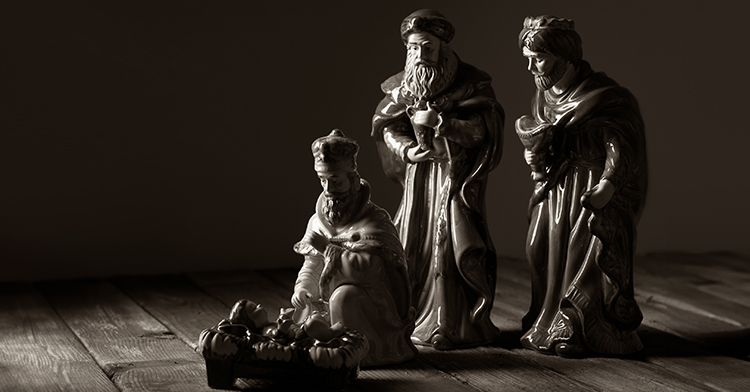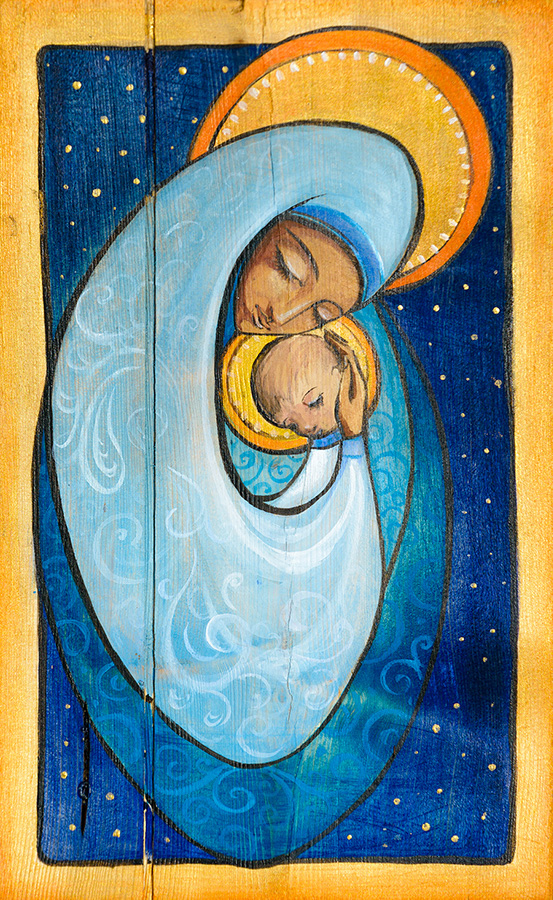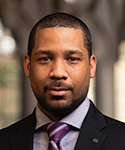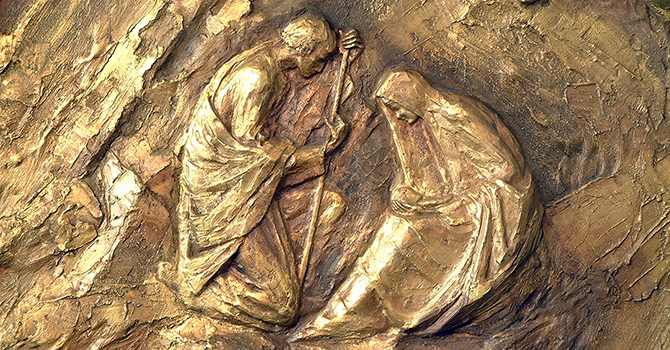Mary and Joseph were momentarily trapped in a side room without a key.
One little angel in a red truck sweater and khakis, wire-and-tinsel wings askew, was “done” long before the play’s end.
Even the setting was off. Because floor repairs in the church’s soaring Gothic Revival sanctuary would not be finished for another week, the annual Christmas pageant was being held in the decidedly less stately gym.
Yet in the midst of all the imperfection, Jesus appeared.
Young eyes shone. Creased faces smiled. And as the star of Bethlehem made its way overhead toward the stage, kings and queens in construction-paper crowns following behind, the gift of the season became just a little more tangible and accessible to all.
Cute kids and familiar miscues aside, the annual Christmas pageant at Church Street United Methodist Church in Knoxville, Tennessee, is different from most such events. The play itself is unrehearsed, a spur-of-the-moment presentation, with the cast -- mostly children and a few adults -- eagerly volunteering for their favorite roles.
And both the actors and the audience include not only church members but a variety of folks from throughout the area, people who live in some of Knoxville’s nicest neighborhoods and people who are homeless, people who have plenty and people who are going through hard times.
“This is not a church that turns its nose up,” said Ricky Hasbrouck, who for nine years lived on the streets and first came to Church Street through its Thursday soup kitchen. “I just love the people here. And I’ve always been one who, if you help me, I’m going to help you.”
On a Sunday night a few weeks ago, Hasbrouck, now a church member, helped in the kitchen. He helped guide the Bethlehem star. He mingled with affluent church families and disadvantaged children and mentally challenged adults.
The church’s parish hall was full of people making crafts, singing songs, taking pictures and sharing grilled-cheese sandwiches and chili at tables decorated with red and green. Soon, they would all head to the gym, the children excited to don their costumes, the adults ready to experience the story anew.
It was an atmosphere at once simple, divine -- and expectant.
The pageant’s beginnings
The Church Street pageant began about 25 years ago with a conversation at a church staff meeting. For several years, the church had held two separate Christmas celebrations, one for members and one for the people who were served by the church’s many outreach ministries.
But then the question came: Why two events?

Over the years, it has offered not only the weekly soup kitchen but also worship services for people who are homeless or otherwise marginalized; after-school and tutoring programs for children from nearby public housing; emergency financial assistance and financial training programs; adult day care/respite care for seniors; a preschool; and partnership with the United Methodist Women’s Wesley House Community Center.
So why not bring these groups and church members together in a fresh way? And at the same time, why not create an off-the-cuff event that would allow for grace, imperfection and joy in the shared experience?
Or, as then-pastor, now-retired Bishop Kenneth Carder put it, why not offer a new way to talk about the inclusiveness of the kingdom? Carder, who pastored the church from 1988 to 1992, remembers a bit of trepidation that first year -- but there hasn’t been any since.

into the gym, but the Christmas miracle still happened.
“It helped make the story of the incarnation more concrete, more relational and more relevant to where the church needs to be today,” he said.
This year, the largest number of participants from outside the church membership came from Wesley House, a 107-year-old Knoxville ministry that provides a variety of services to children and seniors. Volunteers from Church Street work regularly with the families served by Wesley House. In previous years, many children have come through Montgomery Village Ministry, an organization that provides spiritual, economic and educational assistance to area residents.
For some church members at least, the pageant provides “a departure from the regular liturgy and high-church feel,” said pageant organizer Sue Piper.
Community coming together
“It’s small-townish, with all of those mental images of Christmas and the stories we grew up with, the community all coming together to put on a play,” she said. “When I look out on the people who are there, it’s serene and peaceful. There’s this ‘This is how it’s supposed to be’ feel to it.”
After this year’s performance, Pati Scott, a Church Street member for 30 years, was struck by how different the pageant was when held in the gym instead of the sanctuary.
“I think I liked it better,” she said. “We could sit up close. It was more personal. And I think the children felt more at ease.”

“It just seemed so simple at the time,” she said. “It was just something that was meant to fill the time, but it turned into this special thing, and gave them a new sense of worth. We found that some of the homeless adults wanted theirs taken, too. And the van driver, taking the kids home, later told me that they were all clutching their picture frames on the way, so excited to have that keepsake.”
Over the past few years, Lamar said, more church members have been taking an active and visible part in the evening’s festivities. There was a time when members were more likely to be behind the scenes, helping with cookies, costumes, or the gloves, mittens and hats given away at the evening’s end.
“But it’s like we’ve come full circle,” she said. “I’ve heard from so many families how much they’ve been looking forward to being there.”
At this year’s event, for example, neighbors Jenny Herchenrider and Kathleen King, each with two young daughters, piled the four girls onto a bench for a group picture. Four years ago, Herchenrider, with her then-newborn, Abby, portrayed Mary in the pageant. This year, King came as her guest. King is looking for a new church home for her family, and Church Street’s involvement in the broader community “is most definitely important,” she said.
Call for actors
After the photo shoot, King’s girls, ages 2 and 3, crowded around the craft table with a dozen or so elementary-age kids, ranging greatly in experience and background. Later, when “Ephraim” the storyteller began asking for volunteers to take part in the play, the enthusiasm mounted throughout the room.

And when the call went out for kings, queens and wise men, one young boy responded with a cheer of, “Treasure!” as he left the room.
Later, adjusting her crown, one girl easily explained why she chose her role.
“I’ve always been an angel,” she said. “It’s time for something different.”
The Rev. Matt Hampton, a Church Street associate pastor, experienced his first pageant at the church this year. Serving as the evening’s unofficial emcee, he stood at the back of the gym, smiling as the pageant began.
All churches can be stressful at times, he said. They all have certain events or gatherings that can be challenging and require lots of preparation.
“But this is not one of those things,” he said. “This church is mission-minded, and there are a lot of people here who want to make real connections with our neighbors, with the people in our community.”
What we are called to do
As a pastor, Hampton said, he wants Church Street members to grow as human beings, to be happy, healthy and whole. Events such as the Christmas pageant can help that happen.

“This is our path,” he said. “This is what we are called to as disciples.”
His predecessor at Church Street UMC, the Rev. Darryll Rasnake, agrees.
“It’s been interesting how the lines have blurred between those who are volunteering and those who are participating,” said Rasnake, now the pastor at Beaver Ridge United Methodist Church in Knoxville. “When people show up, I think sometimes they don’t really know why they’re there. But it’s always a night filled with a lot of grace.”
Eric Johnson, a lay leader at Hillcrest United Methodist Church in Knoxville, has participated in Church Street’s event in various ways since 2008.
“We talk about how divided churches are -- racially, economically and in other ways,” he said. “But this ‘community Christmas’ seems to be an exception to that. There are the most appropriate interactions that take place there between people that come from very different experiences. It’s unique.”
Carder, the retired bishop and former Church Street pastor, said the pageant has been that way since the beginning.
“Some of the most profound experiences I had while I was at Church Street took place during those events,” he said.
Carder recalled a man who attended one of the Christmas pageants many years ago. Homeless, he was a regular at the church’s soup kitchen, but no one had ever heard him speak.

But at that year’s pageant, the man volunteered to be a king.
“I happened to turn and see him coming up the aisle as the story was being read,” Carder said. “He was bearing a gift. He was carrying the gold. And I was struck by the fact that his eyes were not on the floor. They were clearly on the altar.”
The man approached Mary and Joseph, reverently knelt in front of the baby, and presented the gift as if it were real gold.
Afterward, Carder saw the man taking off his bathrobe costume and told him, “You made a wonderful king.”
“It was the first time -- the only time -- I ever saw him smile,” Carder said. “He looked me squarely in the eye and said, ‘Yes.’ And I told him, ‘You are a king. You’re a child of the king, and that makes you mighty important.’
“You don’t ever know the lasting impact of these experiences, but it’s these moments you remember.”
Questions to consider
Questions to consider:
- How comfortable with imperfection is your church or organization and its leaders? How could it benefit by being more accepting of imperfection?
- How does your organization balance the need for planning and spontaneity?
- Where do you see the incarnation made real? How does your church make it relevant to the world today?
- When did you last have the sense that “this is how it is supposed to be?” What prompted it?
- What can your church do to help people see and appreciate the commonalities they share with others?
- What part would you want? Angel, shepherd or wise man?















